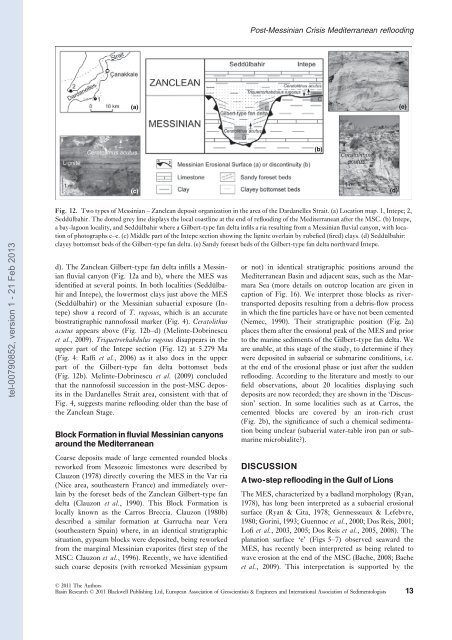Quantification des flux sédimentaires et de la subsidence du bassin ...
Quantification des flux sédimentaires et de la subsidence du bassin ...
Quantification des flux sédimentaires et de la subsidence du bassin ...
You also want an ePaper? Increase the reach of your titles
YUMPU automatically turns print PDFs into web optimized ePapers that Google loves.
tel-00790852, version 1 - 21 Feb 2013<br />
(a)<br />
(c)<br />
d). The Zanclean Gilbert-type fan <strong>de</strong>lta infills a Messinian<br />
fluvial canyon (Fig. 12a and b), where the MES was<br />
i<strong>de</strong>ntified at several points. In both localities (Seddülbahir<br />
and Intepe), the lowermost c<strong>la</strong>ys just above the MES<br />
(Seddülbahir) or the Messinian subaerial exposure (Intepe)<br />
show a record of T. rugosus, which is an accurate<br />
biostratigraphic nannofossil marker (Fig. 4). Ceratolithus<br />
acutus appears above (Fig. 12b–d) (Melinte-Dobrinescu<br />
<strong>et</strong> al., 2009). Triqu<strong>et</strong>rorhab<strong>du</strong>lus rugosus disappears in the<br />
upper part of the Intepe section (Fig. 12) at 5.279 Ma<br />
(Fig. 4: Raffi <strong>et</strong> al., 2006) as it also does in the upper<br />
part of the Gilbert-type fan <strong>de</strong>lta bottoms<strong>et</strong> beds<br />
(Fig. 12b). Melinte-Dobrinescu <strong>et</strong> al. (2009) conclu<strong>de</strong>d<br />
that the nannofossil succession in the post-MSC <strong>de</strong>posits<br />
in the Dardanelles Strait area, consistent with that of<br />
Fig. 4, suggests marine reflooding ol<strong>de</strong>r than the base of<br />
the Zanclean Stage.<br />
Block Formation in fluvial Messinian canyons<br />
around the Mediterranean<br />
Coarse <strong>de</strong>posits ma<strong>de</strong> of <strong>la</strong>rge cemented roun<strong>de</strong>d blocks<br />
reworked from Mesozoic limestones were <strong><strong>de</strong>s</strong>cribed by<br />
C<strong>la</strong>uzon (1978) directly covering the MES in the Var ria<br />
(Nice area, southeastern France) and immediately over<strong>la</strong>in<br />
by the fores<strong>et</strong> beds of the Zanclean Gilbert-type fan<br />
<strong>de</strong>lta (C<strong>la</strong>uzon <strong>et</strong> al., 1990). This Block Formation is<br />
locally known as the Carros Breccia. C<strong>la</strong>uzon (1980b)<br />
<strong><strong>de</strong>s</strong>cribed a simi<strong>la</strong>r formation at Garrucha near Vera<br />
(southeastern Spain) where, in an i<strong>de</strong>ntical stratigraphic<br />
situation, gypsum blocks were <strong>de</strong>posited, being reworked<br />
from the marginal Messinian evaporites (first step of the<br />
MSC: C<strong>la</strong>uzon <strong>et</strong> al., 1996). Recently, we have i<strong>de</strong>ntified<br />
such coarse <strong>de</strong>posits (with reworked Messinian gypsum<br />
Post-Messinian Crisis Mediterranean reflooding<br />
Fig. 12. Two types of Messinian – Zanclean <strong>de</strong>posit organization in the area of the Dardanelles Strait. (a) Location map. 1, Intepe; 2,<br />
Seddülbahir. The dotted grey line disp<strong>la</strong>ys the local coastline at the end of reflooding of the Mediterranean after the MSC. (b) Intepe,<br />
a bay-<strong>la</strong>goon locality, and Seddülbahir where a Gilbert-type fan <strong>de</strong>lta infils a ria resulting from a Messinian fluvial canyon, with location<br />
of photographs c–e. (c) Middle part of the Intepe section showing the lignite over<strong>la</strong>in by rubefied (fired) c<strong>la</strong>ys. (d) Seddülbahir:<br />
c<strong>la</strong>yey bottoms<strong>et</strong> beds of the Gilbert-type fan <strong>de</strong>lta. (e) Sandy fores<strong>et</strong> beds of the Gilbert-type fan <strong>de</strong>lta northward Intepe.<br />
(b)<br />
or not) in i<strong>de</strong>ntical stratigraphic positions around the<br />
Mediterranean Basin and adjacent seas, such as the Marmara<br />
Sea (more d<strong>et</strong>ails on outcrop location are given in<br />
caption of Fig. 16). We interpr<strong>et</strong> those blocks as rivertransported<br />
<strong>de</strong>posits resulting from a <strong>de</strong>bris-flow process<br />
in which the fine particles have or have not been cemented<br />
(Nemec, 1990). Their stratigraphic position (Fig. 2a)<br />
p<strong>la</strong>ces them after the erosional peak of the MES and prior<br />
to the marine sediments of the Gilbert-type fan <strong>de</strong>lta. We<br />
are unable, at this stage of the study, to d<strong>et</strong>ermine if they<br />
were <strong>de</strong>posited in subaerial or submarine conditions, i.e.<br />
at the end of the erosional phase or just after the sud<strong>de</strong>n<br />
reflooding. According to the literature and mostly to our<br />
field observations, about 20 localities disp<strong>la</strong>ying such<br />
<strong>de</strong>posits are now recor<strong>de</strong>d; they are shown in the ‘Discussion’<br />
section. In some localities such as at Carros, the<br />
cemented blocks are covered by an iron-rich crust<br />
(Fig. 2b), the significance of such a chemical sedimentation<br />
being unclear (subaerial water-table iron pan or submarine<br />
microbialite?).<br />
DISCUSSION<br />
A two-step reflooding in the Gulf of Lions<br />
The MES, characterized by a bad<strong>la</strong>nd morphology (Ryan,<br />
1978), has long been interpr<strong>et</strong>ed as a subaerial erosional<br />
surface (Ryan & Cita, 1978; Gennesseaux & Lefebvre,<br />
1980; Gorini, 1993; Guennoc <strong>et</strong> al., 2000; Dos Reis, 2001;<br />
Lofi <strong>et</strong> al., 2003, 2005; Dos Reis <strong>et</strong> al., 2005, 2008). The<br />
p<strong>la</strong>nation surface ‘e’ (Figs 5–7) observed seaward the<br />
MES, has recently been interpr<strong>et</strong>ed as being re<strong>la</strong>ted to<br />
wave erosion at the end of the MSC (Bache, 2008; Bache<br />
<strong>et</strong> al., 2009). This interpr<strong>et</strong>ation is supported by the<br />
© 2011 The Authors<br />
Basin Research © 2011 B<strong>la</strong>ckwell Publishing Ltd, European Association of Geoscientists & Engineers and International Association of Sedimentologists 13<br />
(d)<br />
(e)

















